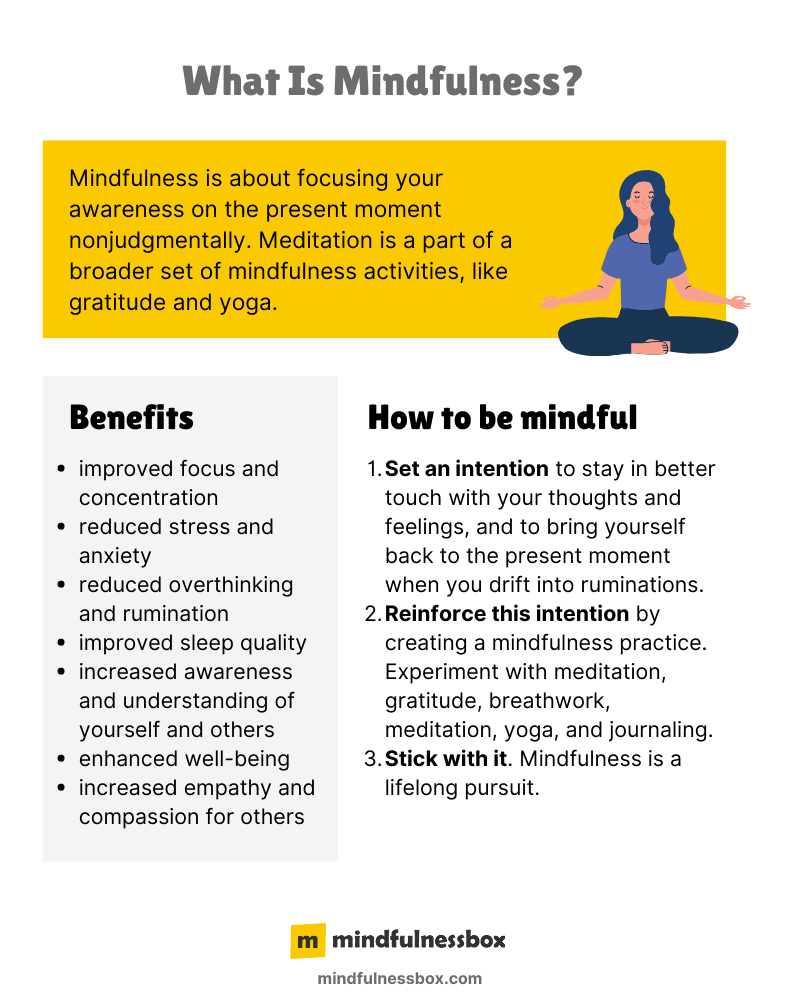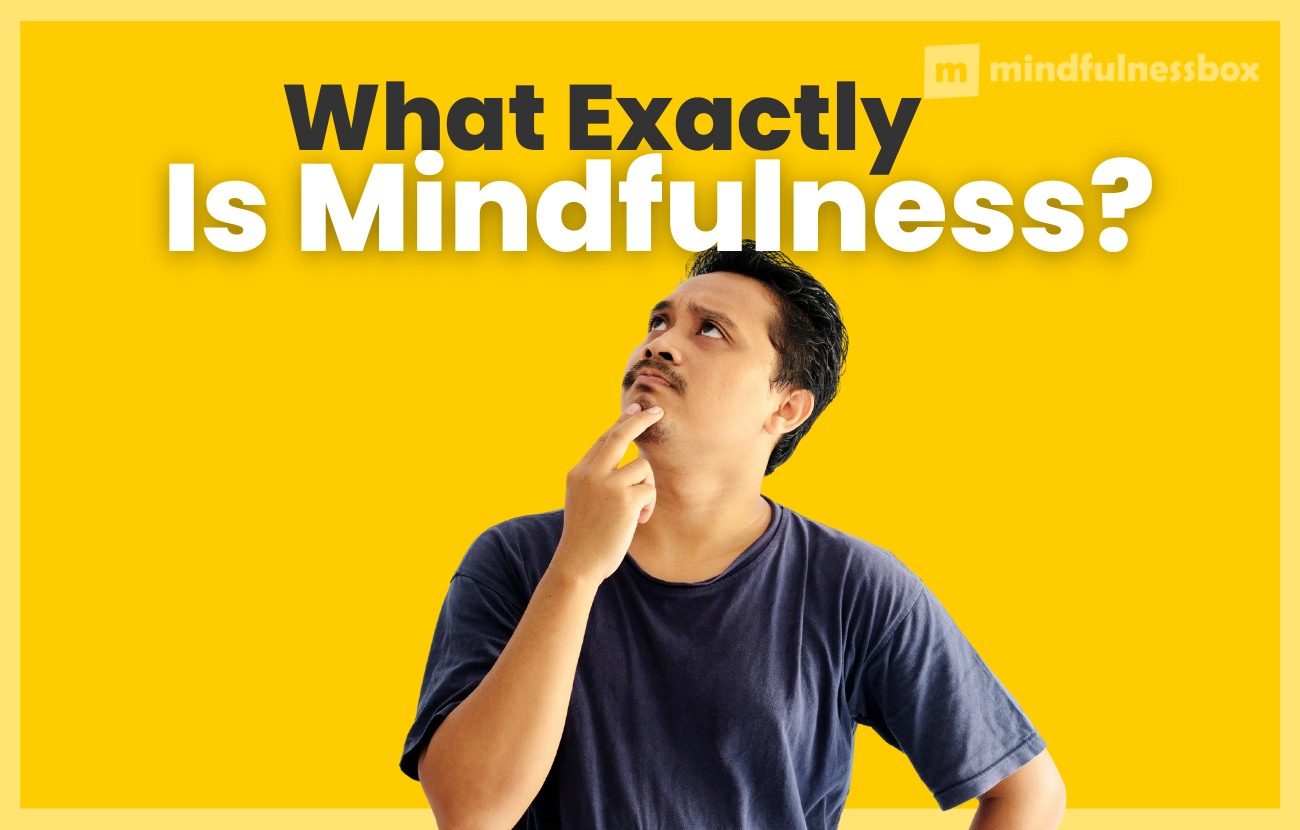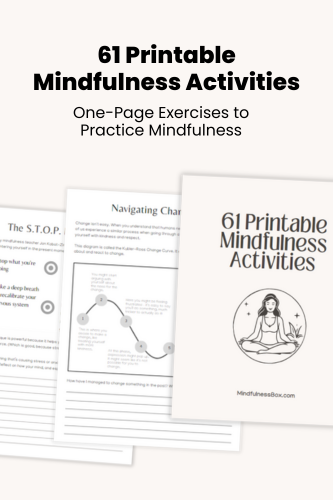What, exactly, is mindfulness? Mindfulness is the practice of purposefully focusing on the present moment nonjudgmentally. It is closely associated with meditation, but mindfulness goes broader, including practices like gratitude that don’t fall under the umbrella of meditation.
Mindfulness is a huge topic, and it’s hard to know where to start, or even nail down exactly what mindfulness is.
Maybe you’re thinking of trying to meditate for the first time. Or maybe someone told you that mindfulness might help with a specific issue like a wandering mind, or anger. You may be confused as to why so many concepts, like affirmations and grounding, fall under the mindfulness umbrella (understandably so).
Get dozens of one-page exercises to help practice mindfulness, meditation, gratitude, and self love. Perfect for printable handouts when teaching mindfulness to groups, students, or in the workplace.
To see examples, plus a full list of the 61 exercises included, click below.
In this article, we’ll dive into common questions about mindfulness. At the end of the article, you’ll find a number of resources to explore this topic further.
What is mindfulness?

Mindfulness is about focusing your awareness on the present moment nonjudgmentally. Meditation can be considered only a part of a broad set of mindfulness activities, like gratitude and yoga.
Mindfulness doesn’t have to involve sitting still and silent for long periods of time. In fact, mindfulness can be practiced in any situation and doesn’t require any special equipment or training.
The goal of mindfulness is to cultivate awareness and acceptance of your thoughts, feelings, and experiences, without judgment. When you’re mindful, you’re more likely to respond thoughtfully instead of reactively to whatever is happening in the present moment.
Mindfulness techniques, like setting an intention for your day, pausing to asses your triggers before reacting, and breathing exercises, can all help in bringing you more into the present.
Mindfulness has been shown to offer a range of benefits, such as improved focus, reduced stress and anxiety, and improved sleep quality.
How to practice mindfulness: a brief intro
Mindfulness is a skill that’s easy to learn, but difficult to master.
To practice mindfulness, simply:
- Give your full attention to whatever it is that you’re doing
- When your attention drifts away, bring it back to the present moment
Take pleasure in those moments that you catch yourself in unawareness. In a way, it can feel like failure, but it’s not.
Each time you catch yourself in unawareness, you’re training your mind to notice when your attention has drifted, and to bring it back.
With enough practice, your skills of attention and your ability to remain in the present moment improve.
1. Cultivate mindful thoughts
Mindful thoughts are thoughts centered nonjudgmentally on the present moment, full of awareness and acceptance of what is happening.
Mindful thoughts can be about anything: the sensations you’re feeling in your body, the sounds you’re hearing, the thoughts passing through your mind, or the environment around you.
Mindful thinking can be thought of as the opposite of rumination. Rumination is when we get stuck in cognitive/emotional loops and overthink things that happened in the past, or that might happen in the future. We can even ruminate about our rumination!
An antidote to this unpleasant cycle is mindful thinking. When you’re mindful, you’re more likely to respond thoughtfully instead of reactively to whatever is happening in the present moment. This can lead to improved communication and relationships, reduced stress, and a more peaceful state of mind.
2. Pay attention to small moments of mindfulness in your life
Over time, you can gain insight into how your mind works. You can recognize patterns. You can understand how to nudge yourself into a different way of being.
Or, at the very least, you can recognize the fact that your awareness is elsewhere. That alone is a win.
Mindfulness isn’t like flipping a switch from Mindless to Mindful. Instead, it’s a series of small victories over years.
At first, my understanding of myself was nonexistent. And to be honest, progress has been slow.
But the small wins stack up.
Six or seven years ago, before practicing mindfulness, it would have been unusual for me to stop in the middle of a task to notice that I’m actually not present.
Now, I catch myself daily in moments of unawareness.
Before, there was no separation between myself and my emotions. I projected them onto the outside world, figuring there must be an external reason I felt bad.
Now, on my best days I can recognize when my nervous system is activated and I’m in a negative emotional state. I can take responsibility for my feelings instead of projecting them.
I still feel like I’m early in the journey of awareness. But over time, the small wins have added up to a meaningful improvement in my life.
3. Treat mindfulness as a lifelong journey
Each of us walks through the world guided by automatic behaviors.
We’ve accumulated them over years of living. When we react to something, oftentimes we’re reacting not only to that event, but to emotional triggers from our past. Our brain operates in this way in order to conserve energy and protect us.
And on top of that, our brain’s biology is wired to zoom out of the present moment frequently in order to keep us safe.
We can be grateful to our brains for keeping us safe.
But as a result, through no fault of our own, our default mode is autopilot mode.
So how do we snap out of autopilot mode?
Unfortunately, it’s not a quick process. Like learning the piano, or any difficult skill, understanding yourself, your emotions, and your patterns of behavior takes time.
We can gently ease ourselves into greater awareness through years of practice.
It’s a lifelong journey, but each step into the present moment makes life better.
Learning more about mindfulness
Interested in exploring mindfulness further? Dive into these additional resources:
- Urge Surfing: How to Stop Cravings Mindfully
- 25 Mindfulness Activities for Adults
- How to Get In Touch with Your Emotions
- The 9 Attitudes of Mindfulness

My mindfulness practice kicked off in 2016 with a ten-day silent retreat. Since then, I’ve read dozens of books about mindfulness and completed hundreds of hours of meditation. Thinking about what makes humans happy, calm, and peaceful is endlessly fascinating to me.


